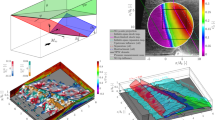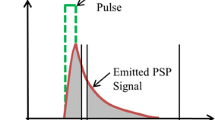Abstract
Strong crossflow and swept separation are key aspects of the flow dynamics of 3-D shock wave/boundary layer interactions. This study explores the global surface pressure field beneath the canonical interaction produced by a sharp fin with deflection angle \(15^\circ\) with a turbulent incoming boundary in a Mach 2 freestream flow. This corresponds to an interaction of moderate strength, and the unsteady pressure distribution captures pressure fluctuations associated with separation shock motion upstream of the interaction. Details of the PSP calibration are also described where the calibration process combines both a priori (with separately painted test coupon) and in situ calibration (with pressure tap measurements during test). Flow features are identified directly from the quantitative pressure distribution and compared to qualitative surface oil flow visualizations. The technique facilitates measurement of the pressure distribution on surfaces that have been difficult or impossible to instrument, such as the face of the shock-generating fin. The unsteady paint response is captured simultaneously with unsteady pressure transducers on the surface underneath the interaction, and a frequency response function based on this comparison is presented. As the results discussed herein demonstrate, the use of PSP allows one to capture significantly more information about this complex, highly three-dimensional interaction with details that are not easily obtained using traditional sensors, while also providing a more informed global view of the interaction. The utility and limitations of the technique in application to supersonic wind tunnel experiments are discussed.
Graphic abstract















Similar content being viewed by others
References
Adler MC, Gaitonde DV (2017) Unsteadiness in swept-compression-ramp shock/turbulent-boundary-layer interactions. In: 55th AIAA aerospace sciences meeting, pp 1–22
Adler MC, Gaitonde DV (2018) Unsteadiness in shock/turbulent-boundary-layer interactions with open flow separation. In: AIAA aerospace sciences meeting, pp 1–26
Adler MC, Gaitonde DV (2019) Flow similarity in strong swept-shock/turbulent-boundary-layer interactions. AIAA J 57:1579–1593
Alvi FS, Settles GS (1990) Structure of swept shock wave/boundary-layer interactions using conical shadowgraphy. In: AIAA paper 1990-1644, pp 1–10
Alvi FS, Settles GS (1992) Physical model of the swept shock wave/boundary-layer interaction flowfield. AIAA J 30(9):2252–2258
Arora N, Alvi FS (2016) Flowfield of a 3-D swept shock boundary layer interaction in a Mach 2 flow. In: 46th AIAA fluid dynamics conference, pp 1–18
Arora N, Ali MY, Zhang Y, Alvi FS (2015) Shock-boundary layer interaction due to a sharp unswept fin an a Mach 2 flow. In: 53rd AIAA aerospace sciences meeting, pp 1–11
Arora N, Ali MY, Alvi FS (2018) Flowfield measurements in a Mach 2 fin-generated shock/boundary-layer interaction. AIAA J 56(10):3963–3974
Baldwin A, Mears LJ, Arora N, Alvi FS, Kumar R, Naughton JW (2019) Skin friction measurements using oil film interferometry in a 3-D supersonic flowfield. AIAA J 57:1373–1382
Casper KM, Wagner JL, Beresh SJ, Spillers RW, Henfling JF, Dechant LJ (2018) Spatial distribution of pressure resonance in compressible cavity flow. J Fluid Mech 848:660–675
Crafton J, Forlines A, Palluconi S, Hsu K-Y, Carter C, Gruber M (2015) Investigation of transverse jet injections in a supersonic crossflow using fast-responding pressure-sensitive paint. Exp Fluids 56(1–15):15
Davis T, Edstrand A, Alvi FS, Cattafesta L, Yorita D, Asai K (2015) Investigation of impinging jet resonant modes using unsteady pressure-sensitive paint measurements. Exp Fluids 56:1–13
Dolling DS (2001) Fifty years of shock-wave/boundary layer interaction research: What next? AIAA J 39(8):1517–1531
Fang S (2010) Application of fast-responding pressure-sensitive paints to a hemispherical dome in unsteady transonic flow. Masters thesis, Ohio State University
Funderburk ML, Narayanaswamy V (2019) Spectral signal quality of fast pressure sensitive paint measurements in turbulent shock-wave/boundary-layer interactions. Exp Fluids 60:1–20
Gaitonde DV (2015) Progress in shock wave/boundary layer interactions. Prog Aerosp Sci 72:80–99
Garg S, Settles GS (1996) Unsteady pressure loads generated by swept-shock-wave/boundary-layer interactions. AIAA J 34(6):1174–1181
Gregory JW, Asai K, Kameda M, Liu T, Sullivan JP (2008) A review of pressure-sensitive paint for high-speed and unsteady aerodynamics. Proc Inst Mech Eng Part G J Aerosp Eng 222:249–290
Gregory JW, Sakaue H, Liu T, Sullivan JP (2014) Fast pressure-sensitive paint for flow and acoustic diagnostics. Ann Rev Fluid Mech 46:303–330
Humble RA, Elsinga GE, Scarano F, van Oudheusden BW (2009) Three-dimensional instantaneous structure of a shock wave/turbulent boundary layer interaction. J Fluid Mech 602:33–62
Hurst AM, Olsen TR, Scott G, VanDeWeert J, Shang T (2014) An experimental frequency response characterization of MEMS piezoresistive pressure transducers. In: Proceedings of ASME Turbo Expo 2014 turbine technical conference and exposition, pp 1–14
Jones C, Clifford C, Bolton JT, Thurow B, Mears LJ., Alvi FS (2018) Preliminary plenoptic PIV results for volumetric measurements of shock wave-boundary layer interactions. In: 2018 AIAA aerospace sciences meeting, pp 1–13
Kim K-S, Lee Y, Alvi FS, Settles GS, Horstman C (1991) Skin-friction measurements and computational comparison of swept shock/boundary-layer interactions. AIAA J 29(10):1643–1650
Korkegi RH (1975) On the structure of three-dimensional shock-induced separated flow regions. AIAA J 14:597–600
Kubota H, Stollery JL (1981) An experimental study of the interaction between a glancing shock wave and a turbulent boundary layer. J Fluid Mech 116:431–458
Liu T, Sullivan JP (2005) Pressure and temperature sensitive paints. Springer, Berlin
Lu FK, Settles GS (1990) Inception length to a fully developed, fin-generated, shock-wave, boundary layer interaction. AIAA J 29(5):758–762
Mukund R, Viswanath PR, Prabhu A, Vasudevan B (2003) Study of glancing and blunt fin shock-boundary layer interactions at low supersonic Mach numbers. NAL Project Report
Musker AJ (1979) Explicit expression for the smooth wall velocity distribution in a turbulent boundary layer. AIAA J 17:655–657
Padmanabhan S, Maldonaldo JC, Threadgill JAS, Little JC (2019) Experimental study of swept impinging oblique shock boundary layer interaction. In: AIAA SciTech 2019 Forum, pp 1–14
Panaras AG (1996) Review of the physics of swept-shock/boundary layer interactions. Prog Aerosp Sci 32:173–244
Peng D, Jensen CD, Juliano TJ, Gregory JW, Crafton J, Palluconi S, Liu T (2013) Temperature-compensated fast pressure-sensitive paint. AIAA J 51:2420–2431
Raju C, Viswanath PR (2005) Application of PSP to the study of 3D shock-boundary layer interaction. In: CIASF 2005 international congress on instrumentation in aerospace simulation facilities, pp 197–201
Schreivogel P, Paniagua G, Bottini H (2012) Pressure sensitive paint techniques for surface pressure measurements in supersonic flows. Exp Therm Fluid Sci 39:189–197
Settles GS, Bogdonoff SM (1982) Scaling of two- and three-dimensional shock/turbulent boundary-layer interactions at compression corners. AIAA J 20:782–789
Settles GS, Lu FK (1985) Conical similarity of shock/boundary-layer interactions generated by swept and unswept fins. AIAA J 23(7):1021–1027
Sugimoto T, Sugioka Y, Numata D, Nagai H, Asai K (2017) Characterization of frequency response of pressure-sensitive paints. AIAA J 55:1460–1464
Sugioka Y, Koike S, Nakakita K, Nonomura T, Asai K (2018) Experimental analysis of transonic buffet on a 3d swept wing using fast-response pressure-sensitive paint. Exp Fluids 59:1–20
Sugioka Y, Hiura K, Chen L, Matsui A, Morita K, Nonomura T, Asai K (2019) Unsteady pressure-sensitive-paint (PSP) measurement in low-speed flow: characteristic mode decomposition and noise floor analysis. Exp Fluids 60:1–17
Sun CC, Childs ME (1973) A modified wall wake velocity profile for turbulent compressible boundary layers. J Aircraft 10:381–383
Threadgill JAS, Little JC (2018) Volumetric study of a turbulent boundary layer and swept impinging oblique SBLI at Mach 2.3. In: 2018 fluid dynamics conference, pp 1–24
Turbeville FD, Schneider SP (2018) Boundary-layer instability on a slender cone with highly swept fins. In: 2018 fluid dynamics conference, pp 1–25
Urzay J (2018) Supersonic combustion in air-breathing propulsion systems for hypersonic flight. Ann Rev Fluid Mech 50:593–627
Vanstone L, Musta M, Seckin S, Clemens N (2018) Experimental study of the mean structure and quasi-conical scaling of a swept-compression-ramp interaction at Mach 2. J Fluid Mech 841:1–27
White FM (2006) Viscous fluid flow, 3rd edn. McGraw-Hill, New York
Zheltovodov AA, Knight DD (2011) Ideal-gas shock wave-turbulent boundary-layer interactions (STBLIs) in supersonic flows and their modeling: three-dimensional interactions, chapter 5. In: Babinsky H, Harvey JK (eds) Shock wave-boundary-layer interactions. Cambridge University Press, New York, pp 137–201
Acknowledgements
This work was supported by the Florida Center for Advanced Aero-Propulsion (FCAAP) at Florida State University, AFOSR Grant FA9550-14-1-0167, and AFOSR Grant W911 NF-17-1-0449.
Author information
Authors and Affiliations
Corresponding author
Additional information
Publisher's Note
Springer Nature remains neutral with regard to jurisdictional claims in published maps and institutional affiliations.
Rights and permissions
About this article
Cite this article
Mears, L.J., Baldwin, A., Ali, M.Y. et al. Spatially resolved mean and unsteady surface pressure in swept SBLI using PSP. Exp Fluids 61, 92 (2020). https://doi.org/10.1007/s00348-020-2924-x
Received:
Revised:
Accepted:
Published:
DOI: https://doi.org/10.1007/s00348-020-2924-x




